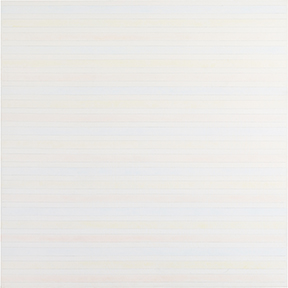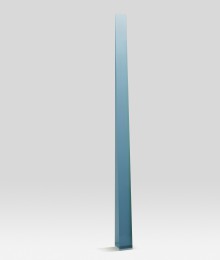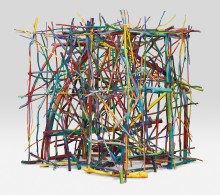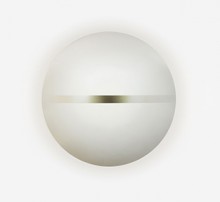Agnes Martin
Untitled #21 1980

© 2014 Agnes Martin / Artists Rights Society (ARS), New York. Reproduction, including downloading of ARS member works is prohibited by copyright laws and international conventions without the express written permission of Artists Rights Society (ARS), New York.
Audio Description (01:05)
Full Audio Transcript (Expand)
Untitled #21
Untitled #21 by Agnes Martin is a six by six foot acrylic and gesso painting with graphite lines on canvas. It was made in 1980 in the post-minimalist style. The work is exceptionally pale and subdued in color, and gently repetitive, like a meditative exercise. It is composed of 43 rows delineated by light, thin graphite stripes. The rows alternate between very faint blue, then yellow, and then red, with a row of white separating each of the colored rows from the next. The rows span the full width of the canvas, repeating in an orderly fashion, with the white rows about half the thickness of the lightly colored ones. While they may appear perfect and uniform from a distance, moving in closer, one can discern the subtle imperfections and fluttery nature of the graphite lines as they journey across textured canvas. Whether viewed up close or from a distance, the near perfection of these rows and the repetition of the alternating colors are soothing in their subtlety and predictability.
Spirituality and the Ethics of Inspiration
Agnes Martin believed one could see perfection in the mind but that painting it was impossible. The meticulously ordered but quiveringly drawn graphite lines in Untitled #21 construct long, narrow rows of color, each fading to white as you approach the painting, and hardening as you step back.
Biographers have noted the depth with which Agnes Martin studied Christian mysticism and Buddhism. Scholars are quick to draw relationships between her spiritual practice and her painting. For Christian influence, one might see the practice of decreation in which a person casts off her ego so God may inhabit her being. The radically austere lines in the painting required a selfless discipline. For Buddhist influence, one might see in Martin’s painting, whose pointed simplicity is clear and direct, the prominent Buddhist teacher Daisetsu Suzuki’s conception of the “beginner’s mind,” which, in its innocence, sees clearly. How might one distinguish between these influences? What is the use of identifying the spiritual tradition that influences painting?
—Callum Tresnan ‘23







